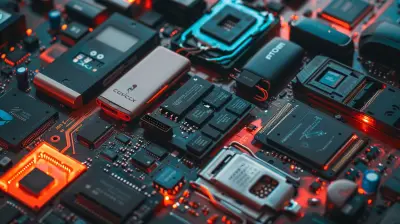Headphone Trends: What to Expect in the Coming Years
22 August 2025
Headphones have come a long way from their bulky, wired ancestors to the sleek, wireless, and feature-packed devices we see today. But what’s next? As technology advances, our expectations for audio experiences grow. Whether you’re a casual listener, an audiophile, or a gamer, the future of headphones is something to be excited about.
In the coming years, we can expect innovations that will change not only how we listen but also how we interact with our headphones. From AI-powered features to revolutionary materials, let's dive into the headphone trends poised to shape the future.
1. The Rise of AI-Powered Headphones
Artificial Intelligence (AI) has already made its way into smartphones and smart homes, and now it’s set to revolutionize the headphone industry. AI-powered headphones will not just play music; they will learn your habits, adjust settings automatically, and even provide real-time language translation.Adaptive Noise Cancellation (ANC)
Many premium headphones already offer Active Noise Cancellation, but AI will take it a step further. Future headphones will analyze your environment and automatically adjust noise cancellation levels. Whether you’re on a crowded subway or in a quiet library, your headphones will fine-tune themselves for the best experience.Personalized Audio Optimization
AI will also tailor sound profiles to individual users. Imagine putting on your headphones, and they instantly adjust based on your hearing ability, preferred genres, and past listening habits. No more messing with equalizer settings—your headphones will do it for you!Real-Time Translation
Ever wished you could understand a foreign language instantly? AI-powered headphones will act as real-time interpreters, allowing seamless conversations between people speaking different languages. This could be a game-changer for travelers and international business professionals.
2. Enhanced Battery Life and Faster Charging
Battery life is one of the biggest pain points for many headphone users. Fortunately, the future promises longer battery life and lightning-fast charging.Graphene Batteries
Graphene-based batteries are expected to replace traditional lithium-ion ones, offering faster charging times and extended battery life. Imagine getting a full day's charge in just 10 minutes—sounds like a dream, right?Solar-Powered Headphones
Some companies are already experimenting with solar-powered headphones, using built-in solar panels to passively charge the device while you’re outdoors. This could mean unlimited listening for users who spend a lot of time outside.
3. Increased Focus on Sustainability
Sustainability is becoming a major concern in the tech industry, and the headphone market is no exception. Brands are moving away from plastic-heavy designs to more eco-friendly materials without sacrificing durability or performance.Biodegradable and Recycled Materials
Future headphones could be made from biodegradable plastics, plant-based materials, or recycled metals. This shift will help reduce electronic waste, a growing issue as more people upgrade their tech devices frequently.Modular Designs
A growing trend in consumer electronics is modularity. Instead of replacing an entire set of headphones when one part breaks, future models may allow you to replace individual components. This not only saves money but also reduces waste.
4. Improved Connectivity and Lossless Audio Support
With streaming services offering high-resolution audio, the demand for lossless sound support in wireless headphones is increasing.Bluetooth LE Audio
Bluetooth is getting a major upgrade with LE Audio (Low Energy Audio), which enhances sound quality while consuming less power. This means better audio performance and extended battery life.Lossless Audio Over Bluetooth
Currently, Bluetooth compression limits sound quality, but new codecs like Qualcomm’s aptX Lossless promise to deliver CD-quality audio wirelessly. Audiophiles will no longer have to choose between high-quality sound and convenience.5. Multi-Device Connectivity and Smart Integration
Headphones are no longer just for listening to music—they’re becoming smart companions that integrate seamlessly with our digital lives.Seamless Multi-Device Switching
We’re seeing an increase in headphones that can connect to multiple devices at once. Imagine switching from your laptop to your phone without manually disconnecting and reconnecting—future headphones will do this effortlessly.Augmented Reality (AR) Soundscapes
With AR on the rise, some future headphones may offer immersive soundscapes that respond to real-world environments. Gamers and VR users will especially benefit from spatial audio that adapts to movements.Voice Assistant Integration
AI-powered assistants like Siri, Google Assistant, and Alexa are already integrated into many headphones, but future models will take this to the next level. They could anticipate your needs, suggest playlists based on your mood, and even remind you of important tasks.6. Health and Wellness Features
Wearable technology is merging with health tracking, and headphones are no exception. Future headphone models may include features designed to monitor and improve your well-being.Heart Rate and Oxygen Monitoring
Some sports-focused earbuds already offer heart rate tracking, but we may soon see more advanced health-monitoring features, such as oxygen saturation and stress level tracking.Hearing Protection and Hearing Aid Features
As awareness of hearing health grows, new headphone designs will focus on protecting your ears. Expect automatic volume adjustments that reduce the risk of hearing damage over time. Additionally, headphones may double as hearing aids for those who need assistance.7. Gesture and Touch Controls
Buttons and voice commands are already common, but the future of headphone controls could be even more intuitive.Air Gestures
Think about controlling your music or answering calls with a simple wave of your hand. Air gesture controls could make interacting with headphones more seamless than ever.Bone Conduction and Open-Ear Designs
Bone conduction technology, which transmits sound through your skull rather than your eardrum, is gaining traction. This allows users to hear music while still being aware of their surroundings—perfect for runners and cyclists.8. Customizable and 3D-Printed Headphones
No two ears are the same, so why should all headphones be one-size-fits-all? In the coming years, headphones might be fully customizable.3D-Printed Earbuds
Companies are developing 3D-printed earbuds designed for a perfect fit. By scanning your ear shape, brands can create custom headphones that offer superior comfort and sound isolation.Interchangeable Parts and Colors
Some companies may offer modular headphones where users can swap ear cups, headbands, and color schemes to suit their style and comfort needs.Final Thoughts
The coming years promise exciting advancements in headphone technology. From AI-powered customization to sustainable materials and health-tracking features, the future of headphones is looking smarter, more convenient, and more innovative than ever.Technology is evolving rapidly, and it's only a matter of time before these features become the new standard. So, whether you're a music lover, gamer, or fitness enthusiast, there’s a lot to look forward to in the world of personal audio.
all images in this post were generated using AI tools
Category:
HeadphonesAuthor:

John Peterson
Discussion
rate this article
1 comments
Helen Wade
Great insights! Excited to see how advancements in battery life and sound quality will evolve.
August 24, 2025 at 12:58 PM

John Peterson
Thank you! Exciting times ahead for headphone technology!


